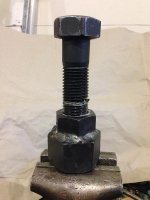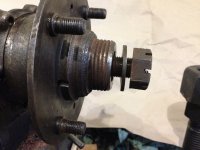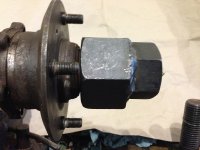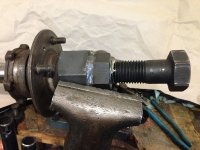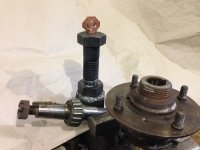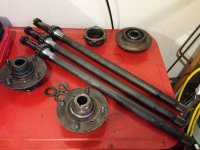I have found a solution for separating the stubborn live axle rear hub and tapered axle shafts. I know most of us have wondered how to remove the stuck tapered hub after 50+ years without damage to the hub or axle. I've searched and looked into all the possibilities from machining a hub fixture with a forcing screw to sending the assembly out to have someone behind a curtain magically separate the assembly without damage. I don't have a machine shop around here (west of the Washington metro area) that would make one without great expense. I also like finding solutions to mechanical problems myself.
Ok, this is how I did it, The parts you need are as follows
1 x Grade 2H steel nut, 1-7/8" x 8 tpi, McMaster-Carr # 90521A037 $10.59
1 x Grade 5 steel bolt, 1-1/2" x 6 tpi, 5" long McMaster-Carr # 91283A452 $12.43
1 x Grade 8 steel nut, 1-1/2" x 6 tpi, McMaster-Carr # 90499A041 $4.43
1 x Multipurpose 110 copper bar 1/4" x 1-1/2" x 6" McMaster-Carr # 8964K851 $11.55
Center the 2 nuts on top of each other and weld them together, I held them together with the bolt during the weld. I had the heat on the mig turned way up and the nut assy took about 45min to cool off enough to move but still to hot to handle by hand.
I then took and cut the copper bar to produce a 1-1/2" square piece and then trimmed the corners to fit loosely into the large nut, this will be what protects the end of the axle from damage during the force applied by the bolt (forcing screw). Lubricate the end of the forcing screw (bolt), bolt threads and the threads of the small nut with lithium grease.
Obtain the axle assy you are separating, remove the cotter pin, loosen the nut and remove the washer then reinstall the nut flush with the end of the axle.
Place the axle assy vertically, place the copper disc on the end of the axle, thread the nut assy with the large nut threading onto the external threads of the hub. The nut should thread on until tight, there will be a 3/16" gap between the bottom of the nut and the 1st step of the hub. Install the forcing screw into the small nut and secure hand tight. I then reset the axle puller assy with the large nut in the vise and used a 2-1/4" x 3/4" drive impact socket (Sunnex obtained from Amazon $23.00) with a 1/2"-3/4" adapter and a 1/2" air impact wrench. I purchased a 3/4" earthquake xt from HF but is is on backorder!
I tightened the bolt as tight as possible and then hit the end of the forcing screw with a large hammer, the 2nd hit had a tone change, I then further tightened and the forcing screw turned in 1/2 a turn and the axle was loose in the hub. I repeated this procedure 3 times with the same success, on each axle assy. The first assy had a damaged hub and was sacrificial, I purchased it from Ebay for the axle shaft only, one of the originals has a damaged inner seal surface.
Next up is to replace the seals and bearings reassemble!
I might just be driving this by spring!
Ok, this is how I did it, The parts you need are as follows
1 x Grade 2H steel nut, 1-7/8" x 8 tpi, McMaster-Carr # 90521A037 $10.59
1 x Grade 5 steel bolt, 1-1/2" x 6 tpi, 5" long McMaster-Carr # 91283A452 $12.43
1 x Grade 8 steel nut, 1-1/2" x 6 tpi, McMaster-Carr # 90499A041 $4.43
1 x Multipurpose 110 copper bar 1/4" x 1-1/2" x 6" McMaster-Carr # 8964K851 $11.55
Center the 2 nuts on top of each other and weld them together, I held them together with the bolt during the weld. I had the heat on the mig turned way up and the nut assy took about 45min to cool off enough to move but still to hot to handle by hand.
I then took and cut the copper bar to produce a 1-1/2" square piece and then trimmed the corners to fit loosely into the large nut, this will be what protects the end of the axle from damage during the force applied by the bolt (forcing screw). Lubricate the end of the forcing screw (bolt), bolt threads and the threads of the small nut with lithium grease.
Obtain the axle assy you are separating, remove the cotter pin, loosen the nut and remove the washer then reinstall the nut flush with the end of the axle.
Place the axle assy vertically, place the copper disc on the end of the axle, thread the nut assy with the large nut threading onto the external threads of the hub. The nut should thread on until tight, there will be a 3/16" gap between the bottom of the nut and the 1st step of the hub. Install the forcing screw into the small nut and secure hand tight. I then reset the axle puller assy with the large nut in the vise and used a 2-1/4" x 3/4" drive impact socket (Sunnex obtained from Amazon $23.00) with a 1/2"-3/4" adapter and a 1/2" air impact wrench. I purchased a 3/4" earthquake xt from HF but is is on backorder!
I tightened the bolt as tight as possible and then hit the end of the forcing screw with a large hammer, the 2nd hit had a tone change, I then further tightened and the forcing screw turned in 1/2 a turn and the axle was loose in the hub. I repeated this procedure 3 times with the same success, on each axle assy. The first assy had a damaged hub and was sacrificial, I purchased it from Ebay for the axle shaft only, one of the originals has a damaged inner seal surface.
Next up is to replace the seals and bearings reassemble!
I might just be driving this by spring!


 Hi Guest!
Hi Guest!

 smilie in place of the real @
smilie in place of the real @
 Pretty Please - add it to our Events forum(s) and add to the calendar! >>
Pretty Please - add it to our Events forum(s) and add to the calendar! >> 
